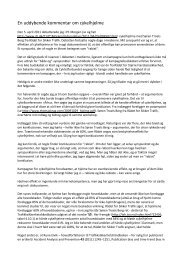Cykling, motion, miljø og sundhed - Thomas Krag
Cykling, motion, miljø og sundhed - Thomas Krag
Cykling, motion, miljø og sundhed - Thomas Krag
You also want an ePaper? Increase the reach of your titles
YUMPU automatically turns print PDFs into web optimized ePapers that Google loves.
prioritized, but at the same time all government funds to promote cycling were cancelled. And no<br />
compensation has been given.<br />
Cost-benefit analyses of cycling<br />
Norway, Finland, Switzerland, Great Britain and Canada, have all carried out cost-benefit<br />
calculations of physical exercise in general or increased cycling in particular. In these analyses, the<br />
large-scale economical benefits of health improvements have been of special interest. The Nordic<br />
Council of Ministers is also preparing a similar analysis. These analyses all speak the same<br />
language: when all relevant factors, including the effect on national health, are taken into account,<br />
investment in cycling turns out to be very profitable. Health has so far – until the present report -<br />
not been taken into account in any Danish economical analysis of traffic. Analyses of traffic<br />
projects have only focused on private and public motor vehicle transportation, and have thus<br />
ignored the possible consequences such projects might have for pedestrians and bicyclists.<br />
To analyze effects on health is a complicated task. One can add up the expenses saved in the health<br />
sector and the benefits of fewer days of absence due to illness. But it is harder to put a price on a<br />
lower mortality rate, and one may question whether it is morally or ethically justifiable to attempt to<br />
do so. However, such estimations are already made in the above-mentioned economical analyses of<br />
investments in car roads and public transportation. Therefore, we have chosen to do the same thing<br />
(in line with the reports from other countries) with respect to walking and cycling. We have studied<br />
whether investments in cycling are profitable when held against other traffic investments.<br />
Large socio-economical benefits from increased cycling<br />
We have used The Danish Ministry of Transport's manual on socio-economic analyses to<br />
investigate the economical consequences of large-scale investment in cycle-initiatives. The study<br />
supposes a funding of 150 million DKK (20,3 million Euro) every year, over a period of 12 years –<br />
presupposing that this will stimulate the inhabitants of cities with a population exceeding 5,000 to<br />
cycle as much as the people in Copenhagen do. However, the study experienced difficulties in<br />
getting Danish figures concerning potential economical benefits of increased physical activity. We<br />
therefore chose to use figures from other countries. A provisional calculation indicates, however,<br />
that Danish figures would be of roughly the same size. Investments in cycle-initiatives turn out to<br />
have a very good profit and cost-benefit ratio, much better, in fact, than what one would normally<br />
expect from economical analyses of traffic projects.<br />
The result seen over a 50 years timescale is a net present value of 23 billion DKK (3.1 billion Euro),<br />
a benefit cost relation of 1.35 and an internal rate of return of 66%, which means very positive. The<br />
health improvements alone have a net present value of 20 billion DKK (2.7 billion Euro). The<br />
results of the calculations are quite robust against changes of the assumptions behind the<br />
calculations. So in spite of substantial uncertainties concerning the involved parameters, the result is<br />
strikingly positive.<br />
Surprisingly the projects' impact on public expenses due to reduced tax-revenue on cars and fuel<br />
and reduced revenue from public transport fares are much higher than the investment in bicycle<br />
infrastructure and campaigning.<br />
The results are robust towards changes of direct investment in bicycle infrastructure and<br />
campaigning and the effects from this, while the value of the health and consumer advantages has a<br />
larger influence, t<strong>og</strong>ether with the relationship between car, public transport, walking, and<br />
bicycling.<br />
- 14 -



